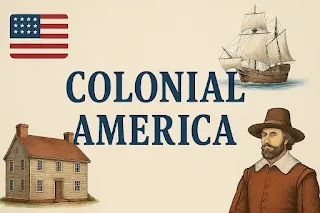Here I am going to provide you 8th Grade U.S. History – Colonial America Notes PDF (1607–1750). You can also Download PDF of these notes. Colonial America (1607–1750) marked the beginning of European settlements, mainly by the British, in North America. People came for religious freedom, economic opportunity, and self-rule. The 13 colonies were divided into New England, Middle, and Southern regions, each with distinct lifestyles. This era laid the foundation for American democracy, culture, and economy. By going through Colonial America Notes you will acquire a better command on this chapter. So, use these notes and do your best!!
Introduction to Colonial America
Colonial America refers to the time between 1607 and 1750, when European nations—especially England—began to establish settlements in North America. These settlements were called colonies and were under the political control of the mother country, mainly Great Britain. Over time, these colonies became more organized, populated, and economically strong. By the mid-1700s, there were 13 British colonies along the eastern coast of what is now the United States.
These colonies became the foundation for American society. The ways people lived, worked, worshipped, and governed themselves during this period had a huge impact on the values and systems we have in the U.S. today.
Why Did Europeans Come to America?
People left Europe and came to the American colonies for different reasons, which can be divided into four major categories:
A. Religious Freedom
- Many people were punished or treated unfairly for their religious beliefs in Europe.
- Pilgrims came to Plymouth to separate from the Church of England.
- Puritans came to reform or "purify" the Church.
- They faced persecution and sought to worship freely.
B. Economic Opportunity
- Europe had limited land and wealth; America offered new opportunities.
- People hoped to own land, access natural resources, and grow rich through trade or farming.
C. Political and Personal Freedom
- Many wanted more say in their governments.
- In the colonies, they could vote in local meetings and help make laws.
D. Forced Migration and Slavery
- Millions of Africans were captured and enslaved.
- They were forced to work on plantations, especially in the Southern Colonies.
- Slavery became a tragic but central part of colonial society.
The 13 Colonies and Their Regions
The 13 colonies were divided into three main regions:
A. New England Colonies
Massachusetts, Connecticut, Rhode Island, New Hampshire
- Geography: Rocky soil, cold winters, short growing seasons
- Economy: Fishing, shipbuilding, timber, small family farms, trade
- Religion: Strong Puritan influence; towns centered around the church
- Society: Town meetings, public education, strict morals
B. Middle Colonies
New York, New Jersey, Pennsylvania, Delaware
- Geography: Fertile soil, moderate climate
- Economy: Grain farming (“Breadbasket”), livestock, crafts, trade
- Religion: Diverse and tolerant; Quakers, Protestants, Catholics, Jews
- Society: Urban centers like New York and Philadelphia
C. Southern Colonies
Maryland, Virginia, North Carolina, South Carolina, Georgia
- Geography: Warm climate, long growing season, rich soil
- Economy: Plantations with cash crops like tobacco, rice, indigo
- Religion: Less central; some tolerance
- Society: Rural areas; wealthy landowners held power; used slave labor
Government in the Colonies
Though under British rule, colonists formed early governments that helped shape American democracy:
| Name | Description |
|---|---|
| House of Burgesses (1619) | First elected legislature in Virginia; allowed self-rule |
| Mayflower Compact (1620) | Agreement by Pilgrims to form a government based on majority rule |
| Fundamental Orders of Connecticut (1639) | First written constitution in America |
Triangular Trade and the Growth of Slavery
The Triangular Trade was a trade system between Europe, Africa, and the Americas.
- Europe sent goods to Africa
- Africa sent enslaved people to the Americas
- Americas sent raw materials back to Europe
The Middle Passage
- The trip enslaved Africans took to the Americas
- Inhumane, cramped, and dangerous conditions
- Many died before reaching land; survivors were sold into slavery
Life in Colonial America
Daily Life
- Most families lived on farms and were self-sufficient
- Children helped with chores and had little leisure time
- Large families were common
Religion
- Central in New England life
- Religious laws shaped communities
- Church attendance was expected
Education
- Focused on reading (especially the Bible)
- Public schools common in New England
- Southern colonies had fewer schools; wealthy used tutors
Important Terms and Concepts
| Term | Meaning |
|---|---|
| Colony | A settlement ruled by a distant country |
| Mercantilism | Economic system where colonies benefit the mother country |
| Indentured Servant | Worked for years in exchange for passage to America |
| Cash Crop | A crop grown to sell (tobacco, cotton, rice) |
| Pilgrims | Religious group that settled Plymouth in 1620 |
| Puritans | Wanted to reform the Church of England; founded Massachusetts |
| Middle Passage | The slave journey from Africa to the Americas |
| Plantation | Large farm using enslaved labor |
Summary: What Did Colonial America Teach Us?
Colonial America was a time of growth, struggle, and change. It was the birthplace of:
- Self-government and democracy
- Hard work and independence
- Religious and economic freedom
But it also included slavery, conflict with Native peoples, and inequality. These experiences helped shape the future of the United States.

